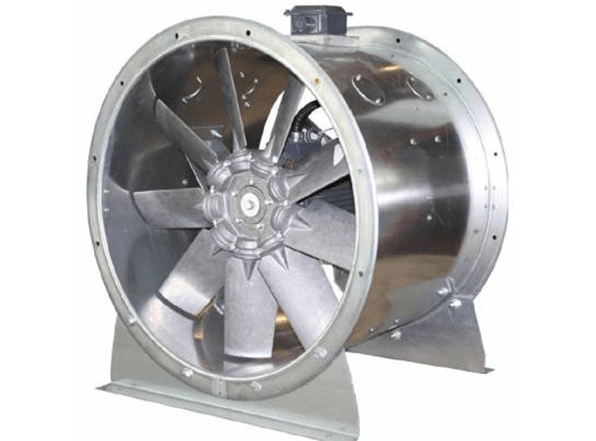Video: Difference between Industrial Axial and Centrifugal Fans

Figure 1: Axial vs. centrifugal fan.
Fans are widely used in factories, mines, tunnels, cooling towers, vehicles, ships, buildings and other fields for ventilation, dust removal and cooling fluid machinery. According to the different directions of air flowing, they are mainly divided into centrifugal, axial, mixed and cross flow types.
Many users are confused about axial and centrifugal fans. This article mainly introduces the difference between axial and centrifugal fans. Hope it will be helpful for you to distinguish between axial flow and centrifugal fans.
1. What is an Industrial Axial Flow Fan?
Axial flow fans are very widely used. “Axial flow" is the airflow in the same direction as the shaft of the blades. For example, electric fans and air conditioner outdoor fans are fans that operate in axial flow mode. It is called "axial flow" because the air flows parallel to the fan axis. Axial flow fans are usually used in situations with higher flow and lower pressure required.
The diameter of small impellers is only about 100 mm, while that of large impellers can reach more than 20 meters. The blades are evenly arranged on the hub, generally 2 to 24. The more blades, the higher the wind pressure.
The blade installation angle is generally 10° to 45°. The larger the installation angle, the greater the air volume and wind pressure.

Figure 2: Axial fan.
2. What is an Industrial Centrifugal Fan?
The centrifugal fan is driven by a power machine (mainly an electric motor) to rotate in a volute casing, and air is sucked in from the center of the impeller through the suction port. Due to the dynamic effect of the blades on the air, the pressure and speed of the air are increased, and it is pushed towards the casing along the blade path under the action of centrifugal force, and is discharged from the exhaust port. Because the flow of air in the impeller is mainly in the radial plane, it is also called a radial fan.
The impeller of a small centrifugal fan is directly mounted on the motor, while medium and large centrifugal fans are connected to the motor through shaft couplings or belt pulleys. Centrifugal fans generally have a single-side air intake and use a single-stage impeller; those with large flow rates can have double-side air intake and use two back-to-back impellers, which is also called a double-suction centrifugal fan.
The impeller is the main component of the centrifugal fan. Its geometry, size, number of blades and manufacturing accuracy have a great impact on performance. The impeller must be statically balanced and dynamically balanced to ensure the smooth rotation of the fan.
According to the different bending directions, the impeller is divided into three types: forward, radial and backward curved.
● The blades of the forward curved impeller are inclined toward the direction of impeller rotation;
● The blades of radial impellers are radial;
● The blades of a backward curved impeller are tilted in the opposite direction of the impeller's rotation.
The forward curved impeller generates the greatest pressure. When the flow rate and rotational speed are constant, the required impeller diameter is the smallest, but the efficiency is generally low. On the contrary, the backward curved impeller generates the smallest pressure, the required impeller diameter is the largest, and the efficiency is generally higher. Radial impellers are somewhere between.

Figure 3: Centrifugal fan.
3. Pros and Cons of Centrifugal Fans and Axial Flow Fans
Advantages of Axial Fans: Good cooling effect, low unit energy consumption, convenience and flexibility.
Disadvantages: Long ventilation time; the moisture removal effect is not obvious, so it is not suitable to use axial flow fans for ventilation of high-moisture grains.
Advantages of Centrifugal Fans: Obvious cooling and moisture removal effects, short ventilation time.
Disadvantages: High unit energy consumption; condensation may occur easily if the timing of ventilation is not well controlled.
In ventilation for the purpose of cooling, axial flow fans should be used for safe, efficient, energy-saving slow ventilation; in ventilation for the purpose of moisture removal, centrifugal fans should be used.

Figure 4: Axial fan.
4. Differences between Axial and Centrifugal Fans from 7 Aspects
Axial fans and centrifugal fans are two common fan types, have similar functions and play the role of ventilation, cooling and ventilation, but there are certain differences in other aspects. So, what are the differences between these two types of fans?
4.1 Principle of Wind Pressure Generated
Centrifugal fans and axial flow fans have different principles of generating wind pressure. The axial flow fan relies on the rotation of the blades to drive the air to move in the axial direction; the centrifugal fan transports the air based on the centrifugal force generated by the rotation of the impeller.
4.2 Air Discharge Direction
The air inlet and outlet of the axial flow fan are on a parallel line. The exhaust direction of the centrifugal fan is perpendicular to the air inlet direction, which can achieve 360-degree exhaust in the specified direction.
4.3 Air Volume and Pressure
In an axial flow fan, the gas completes axial movement during the rotation of the impeller. The wind pressure generated during the movement is very small, but the air volume is relatively large. Centrifugal fans use centrifugal force generated by the rotation of the impeller to transport gas. They generally need a closed installation. The wind pressure is relatively large, but the air volume is not large.
If there are many elbows in the pipeline, relatively long air suction distance and air supply distance, and large pipeline resistance, a centrifugal fan must be used.

Figure 5: Axial fan.
4.4 Performance Characteristics
Axial fans and centrifugal fans also have very different performance characteristics.
Axial flow fans have high airflow speeds and are suitable for situations where large amounts of air or dust particles need to be transported. However, due to the relatively low static pressure, its conveying distance and conveying height are subject to certain restrictions.
Axial flow fans have relatively low noise, but are highly dependent on air flow and are suitable for low pressure and large flow situations.
The centrifugal fan has a low airflow speed but a relatively high static pressure, and is suitable for situations where air or dust particles need to be transported over long distances or at high heights.
4.5 Maintenance
Mainly reflected in the workload of maintenance, axial flow fans are basically maintenance-free, but centrifugal fans need to inspect the impeller and replace lubricating oil after continuous operation.
4.6 Installation
The installation of axial flow fans is relatively simple. They are usually installed directly on the wall or connected to the air duct. The installation of centrifugal fans is more complicated.

Figure 6: Tunnel jet fan installation.
4.7 External Structure
The motor and impeller of the axial flow fan are generally installed in a cylinder, and its overall shape is also cylindrical. The shape of the centrifugal fan casing is a volute structure.
Conclusion
When purchasing fans, we should fully understand the differences between various models and types of fans. While focusing on quality, we also need to carefully screen manufacturers and choose manufacturers with reliable quality and perfect services to avoid subsequent impact on the user experience. O&Kmarts is a reliable platform to buy various industrial fans and can provide a broad brands.

Figure 7: Adding refrigerant to an air conditioner.
6. Sealant and Leak Detection
If your air conditioner requires frequent refrigerant recharging, there might be an underlying issue such as a refrigerant leak. In such cases, it is crucial to address the leak before adding more refrigerant. Applying a sealant to minor leaks can temporarily solve the problem. However, it is advisable to consult a professional technician to properly detect and fix refrigerant leaks.
7. FAQs
7.1 Do Home Air Conditioners Use Freon?
Home air conditioners used to use a refrigerant called Freon, which is a brand name for a type of hydrochlorofluorocarbon (HCFC). However, due to environmental concerns regarding the depletion of the ozone layer and the contribution to global warming, the production of Freon has been phased out in many countries.
Nowadays, home air conditioners typically use refrigerants that are more environmentally friendly, such as hydrofluorocarbons (HFCs) like R-410A or R-32. These modern refrigerants have a lower impact on the ozone layer and a reduced greenhouse effect compared to Freon. It's important to note that replacing or adding refrigerant should always be done by a qualified HVAC technician to ensure proper handling and compliance with regulations.
7.2 How Often Do You Add Refrigerant to an Air Conditioner?
The need for adding refrigerant to an air conditioner can vary depending on various factors. Under normal circumstances, an air conditioner should not require regular refrigerant additions. The system is designed to circulate and reuse the refrigerant continuously.
If your air conditioner is losing refrigerant, it may indicate a leak that needs to be repaired before adding more refrigerant. However, if there is no leak and the system is properly maintained, refrigerant additions should be rare.
It's recommended to have a professional HVAC technician inspect and service your air conditioner regularly to ensure optimal performance and detect any potential refrigerant leaks.
8. Conclusion
Understanding the process of adding refrigerant to an air conditioner can help you identify potential issues and communicate effectively with HVAC professionals. However, due to the safety risks involved, it is always advisable to consult a qualified technician for this task.



